Welcome

Portfolio
A good friend of mine purchased a beautiful piece of mountain property in Evergreen, CO. He commissioned our firm to design his “dream” home. I had a great time on this project, because his family is so lovely, and I enjoyed creating the perfect space for them all to grow and live throughout the years. You find with each home, with each design, the client needs to tweak the plans and layouts to meet their particular needs. I find it humorous when the apologize for “changing my plans.” I reassure them that it’s quite alright, after all, they are taking my drawings, my ideas, and plans and turning these things into their home, which is the most important thing of all.
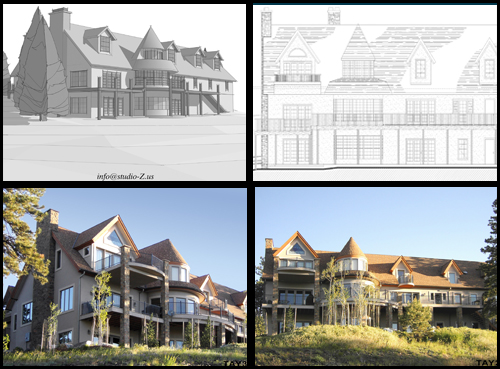
Computer Aided Design has allowed for designers to broaden their services to their clients. In the old days, we would hand draft our designs and sketches. Then with the introduction of AutoCAD, our production time decreased, but designs and sketches were still hand drawn. In the mid-2000’s, I bought my first licensed copy of SketchUp, which allowed for an easier presentation of multiple design options. Then, with the introduction of Revit, our design options have been mashed together: schematic design, design development, and construction drawings can now be handled by one software bundle. In theory, it should be easier. But in practicality, it adds another level of management that we did not have to concern ourselves (architects) with before. On the production side, though, we are able to provide our clients with more services, more options, more details, and a higher level of service.
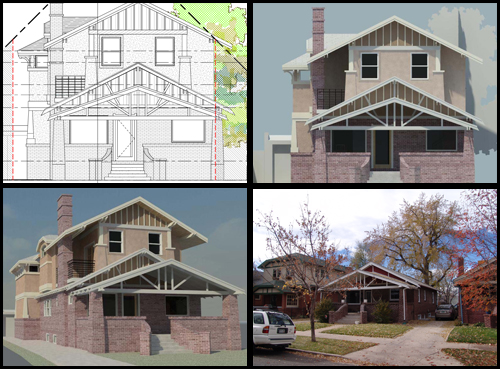
As with many home owners within the area, Wash Park provides quaint starter homes in a desirable neighborhood that are quickly outgrown with the addition of children. Home owners are faced with three decisions: leave the home as-is, and cram everyone in; move; or pop-the-top, i.e. renovate.
Pop-tops in the Wash Park area are a common sight. One of the first questions a home owner asks me is, "What's it going to look like." My answer is always the same: your home will tell me what it wants to look like. I have to factor in neighboring forms, zoning codes/restrictions, and existing site features to find out how the home will evolve. 100% home-owner satisfaction is the goal. I check my ego at the door, and let the home, the owners, and the new design evolve to their satisfaction.
With this design, the Lee's owned a beautiful craftsman-style home, but were crammed into a meager square footage. By adding the second floor, the main level was opened up, the basement was remodeled, and a beautiful wrap-around period-honest porch was added for their entertaining pleasure. Four years later, and two new children, their home is serving their family well.
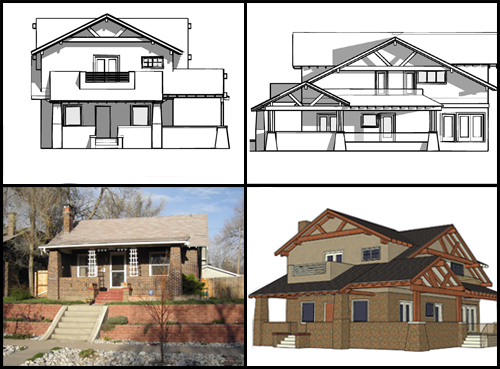
In the spring of 2002, I switched firms, moving to a firm that specialized in custom (high-end) residential designs. This was my first residential design. An 8,000sf home modeled after the Grand Lake Lodge. We chose rough-hewn timber accents integrated with modern functionality. A home tucked into a 35 acre lot overlooking Mt. Evans, the design brought warmth and pride to the family, while capitalizing on the majestic scenic views.
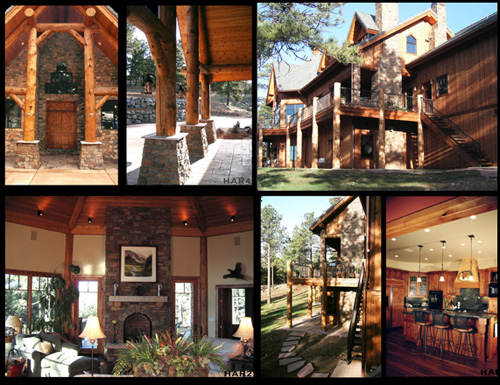
In addition to residential design, I also help clients with small to medium sized commercial projects and tenant finishes.
In addition to residential design, I also help clients with small to medium sized commercial projects and tenant finishes.
When people ask me what I do [for a job], and I tell them that I’m an architect, invariably the next question they ask is, “Oh, what’s your favorite project?” My answer is simple: schools.
I’ve worked on several school projects. The great thing about schools is that you have to be highly-qualified to do this work. It’s a stringent process to get approved with the various school districts. However, once you are working on a project, you realize that the end users really do not care about all of your credentials. They only care about how “fun” you make the project. I’ve done a 12,000sf gymnasium addition, and a 60,000 parking lot to playground conversion. With both of these projects, 99% of the kids have no clue who Aaron Zimmer is. But the reason they are enjoying the installation is because of the thousands of hours I poured into their project. Generations of kids will come and go. Thousands of games will be played. Knees will be skinned, and kings will be crowned at four square. As time goes by, my work will become severely abused. But it makes me smile, thinking of the hundreds and thousands of kids that will enjoy my work, year after year, without ever knowing who I am.
Montessori Peaks Academy, Littleton, CO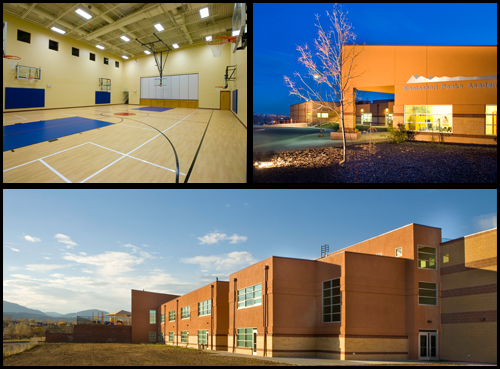
History of Telecomm
 My first exposure to a "cell phone" was when my dad brought home his new work
phone in the late 1980's. What you have to realize is that our home phone was still
a hard-wired Ma-Bell wall-hung phone. Many of you reading this cannot appreciate
living life without twisted cords. We wouldn't get our first "cordless" home phone
until the early 1990's.
My first exposure to a "cell phone" was when my dad brought home his new work
phone in the late 1980's. What you have to realize is that our home phone was still
a hard-wired Ma-Bell wall-hung phone. Many of you reading this cannot appreciate
living life without twisted cords. We wouldn't get our first "cordless" home phone
until the early 1990's.
 The battery pack on my dad's phone was the size of a small suitcase, and weighed
about 40lbs. He had to keep the batteries stored under the backseat of his car, and
could only bring the phone in for an hour or two at a time. The cost for using this
phone ran about $5/minute. Remember, that's 1980's money. Needless-to-say, it
was pretty cool to see him using it while driving. These cell phones linked to various
300'+ towers throughout the metro area. Large 8'h panel antennas were hung
across 3-sectors, and it required 4 antennas per sector: 2 for sending, 2 for
receiving. This is what we commonly refer to a 1G technology. It was line-of-sight,
so the towers could stretch 10, 15, even 20 miles. The reception, however, was
extremely poor. i.e. crackly.
The battery pack on my dad's phone was the size of a small suitcase, and weighed
about 40lbs. He had to keep the batteries stored under the backseat of his car, and
could only bring the phone in for an hour or two at a time. The cost for using this
phone ran about $5/minute. Remember, that's 1980's money. Needless-to-say, it
was pretty cool to see him using it while driving. These cell phones linked to various
300'+ towers throughout the metro area. Large 8'h panel antennas were hung
across 3-sectors, and it required 4 antennas per sector: 2 for sending, 2 for
receiving. This is what we commonly refer to a 1G technology. It was line-of-sight,
so the towers could stretch 10, 15, even 20 miles. The reception, however, was
extremely poor. i.e. crackly.
My interest in cell phones did not surface again until the late 1990's. After college, my first job was for a small firm in Denver that specialized in telecommunication architecture. I describe it like this: you are driving along a particular corridor, or avenue, when you drop a call. This spot becomes a "dead zone" for you, one that you tell your friends and family about when on the phone, "Hey Bob, I gotta go, I'm about to drop your call." This means that particular spot on the carrier's RF data map is a hot spot, or red zone. i.e. It done gotta get fixed! These spots are usually identified by caller complaint frequency. The more subscribers that call and complain, the bigger the red zone and higher the priority becomes to install an "infill" site. The carrier (Verizon, Sprint, AT&T, etc) contacts their real-estate department to find a suitable site. Once a site has been found within the red zone, and land lease agreements have been worked out with the land owner, then the architectural and engineering team is brought in to design zoning and construction drawings. This process may take anywhere from 2 weeks to 2 years, depending on the jurisdiction and sensitivity for the site.
 In the late 1990's, we were putting cell sites EVERYWHERE. At this
time, it was mostly just 1G installations, with 2G infills. Remember
those Sprint commercials, where they focused on how clear their lines
were that you could hear a pin drop? That was essentially due to
upgraded digital technology. Or 2G upgrades. We still installed 4
antennas per sector, but now we had one large panel antenna for send
and one for receive (1G), then used two smaller dual-band antennas
that accommodated both send and receive for 1G and 2G. Digital
service drastically improved the quality of calls, but the send/receive
distance was reduced to 5 or 10 miles max. Therefore, more and more cell sites began popping up
throughout the city and surrounding rural areas. Enter: Zoning Conflicts.
In the late 1990's, we were putting cell sites EVERYWHERE. At this
time, it was mostly just 1G installations, with 2G infills. Remember
those Sprint commercials, where they focused on how clear their lines
were that you could hear a pin drop? That was essentially due to
upgraded digital technology. Or 2G upgrades. We still installed 4
antennas per sector, but now we had one large panel antenna for send
and one for receive (1G), then used two smaller dual-band antennas
that accommodated both send and receive for 1G and 2G. Digital
service drastically improved the quality of calls, but the send/receive
distance was reduced to 5 or 10 miles max. Therefore, more and more cell sites began popping up
throughout the city and surrounding rural areas. Enter: Zoning Conflicts.
Nobody likes to look at ugly cell towers. Therefore, in the late 1990's we began experiencing major conflicts throughout the zoning jurisdictions. Codes were re-written and adopted to limit how cell sites were erected. Various techniques were adopted to "hide" our antennas and poles:
- On brick buildings, antennas were painted like bricks
- On flat roofs, parapets were installed to hide antennas
- Silver ground poles were abandoned for dark charcoal gray or brown poles
- Ground pole heights became limited to 35'max
- "Stealth" installations, such as fake pine trees and fake chimneys were introduced
- Fake flag poles (I hate these!)
- Fake church crosses
 Not all of these attempts to hide the antenna installations were
successful. Driving around town I can find examples of a LOT of bad
installations. Here in Colorado, if you drive from Denver to Colorado
Springs, you can see these big, ugly, out of place fake pine trees
sticking up. Terrible.
Not all of these attempts to hide the antenna installations were
successful. Driving around town I can find examples of a LOT of bad
installations. Here in Colorado, if you drive from Denver to Colorado
Springs, you can see these big, ugly, out of place fake pine trees
sticking up. Terrible.
Good architects became successful architects by providing clean, non-obtrusive, non-noticeable installations throughout town: I-70 cross, stealth pine-tree, fake barns, fake windmills, fake roof gables. Truth be told, carriers will avoid going "stealth" at all cost, because these installations do not come cheaply.
SMS vs. Push-to-Talk In the mid-2000's, there was a war being waged for top dog in the industry. Sprint, AT&T, and
Verizon were all competing for consumer loyalty. While AT&T and Verizon had continued to expand
their markets and infill their networks, AT&T went a different route. They purchased a smaller
telecommunication company, acquiring all of their equipment and installations throughout the U.S.
and integrating their mobile-to-mobile "push to talk" technology. Thus, Nextel now became integrated
into the Sprint network. Together, Sprint and Nextel had a lot to offer. Sprint had a good, strong urban
2G network for their phones, where Nextel's rural network relied on radio-like technology to talk from
one phone to another like a walkie-talkie. This system was great for contractors and companies that
had crew throughout rural areas as they could communicate with each other on a much broader range,
similar to truckers and law enforcement who continue to use the radio technologies.
In the mid-2000's, there was a war being waged for top dog in the industry. Sprint, AT&T, and
Verizon were all competing for consumer loyalty. While AT&T and Verizon had continued to expand
their markets and infill their networks, AT&T went a different route. They purchased a smaller
telecommunication company, acquiring all of their equipment and installations throughout the U.S.
and integrating their mobile-to-mobile "push to talk" technology. Thus, Nextel now became integrated
into the Sprint network. Together, Sprint and Nextel had a lot to offer. Sprint had a good, strong urban
2G network for their phones, where Nextel's rural network relied on radio-like technology to talk from
one phone to another like a walkie-talkie. This system was great for contractors and companies that
had crew throughout rural areas as they could communicate with each other on a much broader range,
similar to truckers and law enforcement who continue to use the radio technologies.
However, it wasn't the adults that won this war.
 I remember watching my sister and her boyfriend communicate to one-another via "text" messaging
during dinner one evening at a restaurant. Her boyfriend (now my brother-in-law: Hi Nate!), was
texting with one hand under the table. It was mildly annoying, because I knew what he was doing, he
was "talking" to my sister with some "secret" code. Adults, you see, still preferred to talk in person or
by using a very clear telephone conversation. But these two kids, just like the rest of the teenage
population that was acquiring cellphones at a rapid rate - they were revolutionizing the way in which
communication would evolve.
I remember watching my sister and her boyfriend communicate to one-another via "text" messaging
during dinner one evening at a restaurant. Her boyfriend (now my brother-in-law: Hi Nate!), was
texting with one hand under the table. It was mildly annoying, because I knew what he was doing, he
was "talking" to my sister with some "secret" code. Adults, you see, still preferred to talk in person or
by using a very clear telephone conversation. But these two kids, just like the rest of the teenage
population that was acquiring cellphones at a rapid rate - they were revolutionizing the way in which
communication would evolve.
 Long story short: "push to talk" technology was beat out by "texting", I gave
into the teenage craze and took up texting, lot's more motor vehicle
accidents have been caused, and 3G technology was born. 3G could piggy-
back on 2G antennas, which was convenient, however the carriers soon
found that their antennas and coaxial cables and equipment were being
over-loaded by text-crazy customers using a confusing, barely audible
texting language. New cost plans were developed, new marketing strategies
were pushed, and Sprint was left with a billion-dollar gamble that faded
away.
Long story short: "push to talk" technology was beat out by "texting", I gave
into the teenage craze and took up texting, lot's more motor vehicle
accidents have been caused, and 3G technology was born. 3G could piggy-
back on 2G antennas, which was convenient, however the carriers soon
found that their antennas and coaxial cables and equipment were being
over-loaded by text-crazy customers using a confusing, barely audible
texting language. New cost plans were developed, new marketing strategies
were pushed, and Sprint was left with a billion-dollar gamble that faded
away.
 3G technology did not need new antennas, for the most part. Most of the 3G upgrades were
accomplished with simple equipment swaps and additions. In some cases, antennas were swapped out,
either for dual-band or quad-band antennas. Carriers, such as Verizon, started embracing the SMS
revolution and provided carriers with "VCast" technology, or the ability to stream live audio and video. It
was money in the bank for AT&T and Verizon. Their networks were already in place and able to handle
the data. Best of all, they could charge more for data usage. Sprint limped along, but found themselves
lagging behind now in overall coverage. They began marketing more towards urban users, much like
the newer cell companies entering the market: T-Mobile, Cricket, and
Cingular. These companies could do simple 2G and 3G installs with minimal
cost and impact, while avoiding covering rural areas by not installing 1G
antennas or equipment. One work-around that they used was leasing tower
space and usage from competitive carriers. For example, if you had a T-
Mobile phone, but were out in the middle of Kansas where they did not
have a tower install, you could use your phone by using a nearby Sprint
tower. You didn't have to consciously make this effort, your phone did this
automatically, and you didn't have to worry a bit. That is, until your monthly
bill came and you noticed the infuriating line item labeled, "Roaming
Charges".
3G technology did not need new antennas, for the most part. Most of the 3G upgrades were
accomplished with simple equipment swaps and additions. In some cases, antennas were swapped out,
either for dual-band or quad-band antennas. Carriers, such as Verizon, started embracing the SMS
revolution and provided carriers with "VCast" technology, or the ability to stream live audio and video. It
was money in the bank for AT&T and Verizon. Their networks were already in place and able to handle
the data. Best of all, they could charge more for data usage. Sprint limped along, but found themselves
lagging behind now in overall coverage. They began marketing more towards urban users, much like
the newer cell companies entering the market: T-Mobile, Cricket, and
Cingular. These companies could do simple 2G and 3G installs with minimal
cost and impact, while avoiding covering rural areas by not installing 1G
antennas or equipment. One work-around that they used was leasing tower
space and usage from competitive carriers. For example, if you had a T-
Mobile phone, but were out in the middle of Kansas where they did not
have a tower install, you could use your phone by using a nearby Sprint
tower. You didn't have to consciously make this effort, your phone did this
automatically, and you didn't have to worry a bit. That is, until your monthly
bill came and you noticed the infuriating line item labeled, "Roaming
Charges".
For the latter part of the decade, consumers were focused on upgrading their devices. First it was the Palm Pilot that allowed for full-on email messages to be written. Blackberry commanded most of the business market. New fancy-type phones were introduced to allow users to play songs cast over the networks. Picture phones were introduced. Full-on keyboards replaced the ever-annoying thumb typing. Flip phones were replaced with big screen phones that could perform limited internet surfing.
While all this was taking place, the carriers were doing some behind-the-scenes "maintenance" to their sites. They were bringing fiber optics to all of their existing sites, and specifying it for all of their new sites. You see, until now, 1G, 2G, and 3G was all accomplished by using Ma-Bell's copper phone network. Fiber optics was mostly used for bringing hi-speed internet to buildings. But the carriers knew their limitation to streaming data across their network and began planning for the next revolution.
 The introduction of the iPhone brought pro's and con's. It was a slick
phone that was admired by everyone on the AT&T network, and envied by
those of us on the Verizon network. But for the first iPhone users, there
was a major disappointment: data usage. It was slow and unreliable.
That's because the data was being pushed thru the slower, out-dated
copper lines. It would be like trying to water a golf-course with a
household garden hose.
The introduction of the iPhone brought pro's and con's. It was a slick
phone that was admired by everyone on the AT&T network, and envied by
those of us on the Verizon network. But for the first iPhone users, there
was a major disappointment: data usage. It was slow and unreliable.
That's because the data was being pushed thru the slower, out-dated
copper lines. It would be like trying to water a golf-course with a
household garden hose.
Not to fret, much preparations were in the work to make things better. Verizon had spent nearly two years and an untold amount of money upgrading their network. When they finally acquired the right to add their phone to the network, their 4G was alive and operation. Not to mention, their 3G was well oiled and running smoother than ever.
All of the carriers found themselves embracing both Android and Apple technologies, and building new data plans to embrace their 3G and 4G consumer needs. New devices are still being developed monthly and marketed to the World-wide consumer base.
 Nowadays, a consumer can upload a DVD to dropbox, download it to their phone, watch the movie,
transfer it to their ipad, drive to grocery store, buy milk, come back and not miss a single beat. All this
while remaining in their pajamas.
Nowadays, a consumer can upload a DVD to dropbox, download it to their phone, watch the movie,
transfer it to their ipad, drive to grocery store, buy milk, come back and not miss a single beat. All this
while remaining in their pajamas.
The 1G to 4G revolution has been remarkable. When my father first had his phone, it was limited to sharply-dressed business men and pool-side movie stars. Now, every teenager, soccer mom, and double-digit sibling are connected to each other through their smartphone. Sadly, when you see people getting evicted from their homes on the nightly news, you see them clutching to their $500 phone. There are people old enough to remember the absurdity for paying Ma-Bell $20 per month for leasing their wall-hung telephone. It's a new world now, oh how we've evolved.
Here at ZYmR.co, I've embraced this niche in the architectural market: I make your cellphone work better.

My Mobile Evolution
 In 1986, my dad brought home the first cell phone I remember seeing. At this time, our home phone
was still hard wired to the wall. We would not get our first cordless home phone until the early 1990's.
So to have a phone that was able to be used in his pimped-out Ford Escort work wagon - yeah, that was
pretty cool!
In 1986, my dad brought home the first cell phone I remember seeing. At this time, our home phone
was still hard wired to the wall. We would not get our first cordless home phone until the early 1990's.
So to have a phone that was able to be used in his pimped-out Ford Escort work wagon - yeah, that was
pretty cool!
 For the next dozen years, I remained unplugged from the wireless arena. Then, in the spring of 1998,
two weeks before my wife was due with our first child she brought home not one, but two "cell"
phones. Verizon was offering mobile-to-mobile minutes via a family plan, and she wanted us to be in
touch with each other for the BIG event. So in 1998, we were new owners of tri-band (1G and 2G urban
coverage PLUS 1G rural roaming coverage) Qualcomm QCP's. Our life would never be the same.
For the next dozen years, I remained unplugged from the wireless arena. Then, in the spring of 1998,
two weeks before my wife was due with our first child she brought home not one, but two "cell"
phones. Verizon was offering mobile-to-mobile minutes via a family plan, and she wanted us to be in
touch with each other for the BIG event. So in 1998, we were new owners of tri-band (1G and 2G urban
coverage PLUS 1G rural roaming coverage) Qualcomm QCP's. Our life would never be the same.
Although they proved unnecessary for the delivery needs of my first child, these phones served us well. We got use to calling each other on the mobile cellular telephone, as well as calling our friends and families after 9pm and on the weekends (per our data plans). Within a year of acquiring our phones, Verizon added a brilliant new option to their service: unlimited mobile-to-mobile calling within the network. Soon thereafter, we convinced many friends and family members to go with Verizon so that we could talk for "free". All day. Any day.
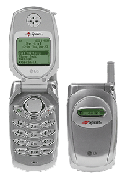 Soon, cooler phones to began to emerge. By 2001 (the birth of my second child), I was ready for
an upgrade. I chose the VX-4500. This was a sweet flip phone that vibrated when a call came in
and allowed me to see what time it was without flipping the phone open. Don't laugh - these were
significant upgrades: I had reached an elevated status! This phone served me well for three years, and
then I dropped it outside of Annie's restaurant during a mid-summer rain storm. It was ruined. Time for
a NEW phone!
Soon, cooler phones to began to emerge. By 2001 (the birth of my second child), I was ready for
an upgrade. I chose the VX-4500. This was a sweet flip phone that vibrated when a call came in
and allowed me to see what time it was without flipping the phone open. Don't laugh - these were
significant upgrades: I had reached an elevated status! This phone served me well for three years, and
then I dropped it outside of Annie's restaurant during a mid-summer rain storm. It was ruined. Time for
a NEW phone!
 In 2004, vibrate mode and caller I.D. were standard options on flip phones. I acquired a similar phone
with some new "improved" enhancements. The LG VX4500 had a bigger viewing screen, color graphics,
better ringtones and VCast abilities. This was a great phone that served me well..until I moved offices.
In 2004, vibrate mode and caller I.D. were standard options on flip phones. I acquired a similar phone
with some new "improved" enhancements. The LG VX4500 had a bigger viewing screen, color graphics,
better ringtones and VCast abilities. This was a great phone that served me well..until I moved offices.
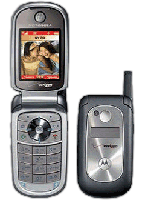 In 2005, my new place of employment was in a old brick building in the Park Hill area of Denver. The
minute I stepped in the building, I would lose all mobile coverage. Can you hear me now? After trying
three different LG phones, I switched to a Motorola phone: the v325 unit. Again, this phone served me
very, very well. The antenna was remarkable, and my calls were seldom dropped. It was like upgrading
from the old green-screened gameboy to the updated COLOR version.
In 2005, my new place of employment was in a old brick building in the Park Hill area of Denver. The
minute I stepped in the building, I would lose all mobile coverage. Can you hear me now? After trying
three different LG phones, I switched to a Motorola phone: the v325 unit. Again, this phone served me
very, very well. The antenna was remarkable, and my calls were seldom dropped. It was like upgrading
from the old green-screened gameboy to the updated COLOR version.
 By the mid-2000's I was carrying 3 devices in my car: my phone, my palm pilot, and my laptop. My
laptop and palm pilot were synced together so that my calendar and contacts were constantly up-
to-date. But what I REALLY wanted was to marry the palm and ph one devices. Introduce: the Palm
Pilot 700p. It was a brilliant device that allowed me to manage one lone device. I could keep track of
meetings, call any client or consultant, surf the web, play games, watch ripped MPEG videos, listen my
mp3's, take notes, draw field sketches, text, email, and make phone calls. This phone was all I needed,
and it served me well. A lot of people switched from the Palm to a Blackberry, and then to the iPhone.
For me, all was good with the Palm Pilot, and I used it for many years.
By the mid-2000's I was carrying 3 devices in my car: my phone, my palm pilot, and my laptop. My
laptop and palm pilot were synced together so that my calendar and contacts were constantly up-
to-date. But what I REALLY wanted was to marry the palm and ph one devices. Introduce: the Palm
Pilot 700p. It was a brilliant device that allowed me to manage one lone device. I could keep track of
meetings, call any client or consultant, surf the web, play games, watch ripped MPEG videos, listen my
mp3's, take notes, draw field sketches, text, email, and make phone calls. This phone was all I needed,
and it served me well. A lot of people switched from the Palm to a Blackberry, and then to the iPhone.
For me, all was good with the Palm Pilot, and I used it for many years.
In the early months of 2010, there was a buzz floating throughout the internet that the iPhone would soon be available on the Verizon network. My palm pilot was beginning to show signs of wear and tear. All I was trying to do was hold onto it long enough until the iPhone hit the market. Months would go by, and I was holding onto the hope that the iPhone would soon be mine.
Near the end of November, 2010, my Palm Pilot quit making calls. It was time for a new phone, and the iPhone was yet available. So I walked into the Verizon store. When I saw the new Android R2D2 Droid 2 phone, it was love at first sight. Yes, I am a Star Wars nerd. But I grew up on the series, and it was a cool phone.

I've had this phone for a year now, and it has proved to be a fantastic investment. My wife ended up choosing the iPhone 4, which she loves. Truth is, I enjoy the customization abilities with the Android software, and she enjoys the mindless operation and ease of use that comes with the iPhone. Each to their own.
There are many phones out there. And half of them have the Android operating software. But of those phones, not many people own an R2D2 phone - so I feel pretty special.
Regional (State) Licensure

FTP
Contact Info
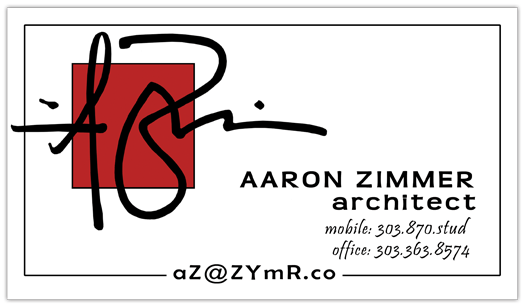
About Me
Aaron Zimmer
* Principal / Owner / Janitor *Technical Skills:
I am a skilled architect trained in commercial, residential, and telecommunication design. One of my greatest assets is my ability to handle projects solo or within a team-oriented environment. I have strong relationship and managerial skills, and a deep understanding of construction as well as a passionate dedication to perfection in all my endeavors.
I am expert on AutoCAD and have been using it since release 10 in 1989. I am proficient with various BIM software: AutoDesk REVIT, SketchUp by @Last Software, and ArchiCAD by Graphisoft.
I am well skilled with Microsoft Word, Excel, and Powerpoint; as well as Adobe Photoshop and Premiere, HTML and FTP encoding and various independent graphic programs.
Education:
December 2002:
NCARB Architectural License State of Colorado #203707
1996-1998
3.875 GPA
University of Nebraska at Lincoln - Masters in Architecture
1992-1996
3.45 GPA
University of Nebraska at Lincoln - Bachelor of Science in Architectural Studies
(emphasis in Ancient History, Sociology,and Photography)
Achievements:
1990 - Received the B.S.A. Eagle Scout award
1992 - Awarded the UNL Regent’s full-academic scholarship
1997 - Fully restored a 1973 VW Thing
1999 - Became a father
2004 - My first custom-design home featured in “Timber Home” magazine
2007 - Winner of “Best non-beer” Gold Medal for homemade hard cider
2008 - Full restoration of a 1963 Airstream (Silver Bullet) Trailer
2009 - Completed a 99,500 word novel (to be published shortly)
2011 + Still searching…
On a Personal Note:
Originally from Nebraska, I relocated to Colorado in 1998 with my wife, Kathy. We now have 3 children (Jade – 12yrs, Kaleb – 9yrs, and Kim – 4yrs) and a yellow Lab named Gwen. I enjoy spending my time playing and reffing hockey, snow-boarding and skiing, cycling, competing in triathlons, zymurgy, camping, fishing, and spending time with my family and friends. I am also an honorary member of the Kerr Clan from Scotland.
Work History:
Company: ZYmR.co
Location: Aurora, CO.
Position: Principal / Owner
Dates: May 2011– Current
Lead designer / engineer for various telecommunication projects spanning across six western states; responsible for site visits, audits, zoning and construction drawings, jurisdictional and client/carrier coordination, drafting, photosimulations, finance and book-keeping, maintenance (i.e. vacuuming my home office), hardware and internet management, web support, graphics and marketing departments, construction administration, and sole-carrier of all licenses and insurances.
Hours of operation: 9am-3pm….life is GREAT!
Company: T*Rex Architex
Location: Denver, CO.
Position: Senior Project Architect
Dates: April 2006 – May 2011
Architect and Manager for AT&T Telecommunication sites; responsible for managing all commercial design projects; work closely with engineers, contractors, and local jurisdictions to create environmentally friendly installations throughout the Front Range. Job duties encompassed all aspects of project and office management.
Company: Division One Design/Build
Location: Denver, CO.
Position: Project Architect/Manager
Dates: August 2005 – April 2006
Architect and Manager for AT&T Telecommunication sites; responsible for managing all commercial design projects; work closely with engineers, contractors, and local jurisdictions to create environmentally friendly installations throughout the Front Range. Job duties encompassed all aspects of project and office management.
Company: T*Rex Architex
Location: Denver, CO.
Position: Project Architect/Manager
Dates: April 2006 – May 2011
Project Architect and Construction Manager for commercial design-build firm. Managed clients and projects from initial design concepts through completed construction. Duties included all aspects of design, cost bidding, and construction management.
Company: D.H. Ruggles & Associates
Location: Denver, CO.
Position: Project Architect & Assoc. Vice President
Dates: May 2002 – May 2005
Project Architect and designed of high-end residential. Responsible for all aspects of project management and overseeing projects evolve from initial client contact through completed construction. Also lead designer and manager of all medium-sized commercial projects.
Company: T*Rex Architex
Location: Denver, CO.
Position: Intern Architect
Dates: May 1998 – May 2002
Project Manager for Sprint Telecommunication Phase III Build-Out. Job duties encompassed all aspects of project management and provided me with a well-rounded experience in commercial architecture.
Company: Leiniger Construction
Location: Lincoln, NE.
Position: Framer
Dates: 1996 - 1997
Working in the field is where I learned to appreciate architecture as I used my hands to assemble a drawing set. It was also where I gained a tremendous amount of respect for the skilled laborers and all that they do. Trading my books for a tool belt in the summers armed me with many of the practical skills I use today. In my heart I still consider myself a framer.
Company: J.R. Perrin
Location: Omaha, NE.
Position: Intern Architect
Dates: 1994 - 1996
Responsible for creating hand-drafted drawings, modifying redlines and original vellum drawings, running Diazo prints (blue prints), and holding the dumb-end of the tape. Bob Perrin was my neighbor, my first boss, my inspiration to pursue my architecture degree(s) and still remains my professional mentor to this day.









